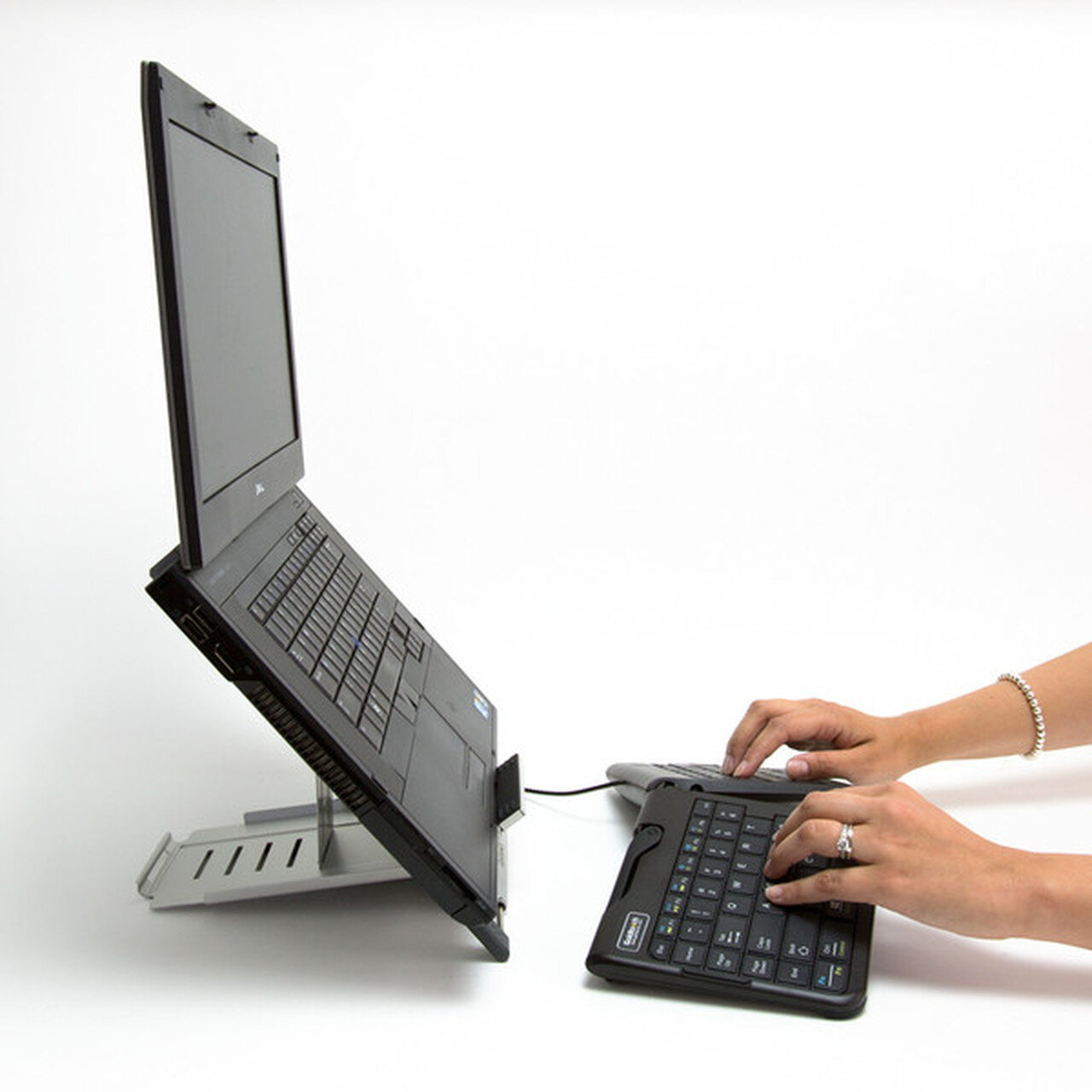Earth Ergo: Workstation Setup
The earth element provides structure and stability in our world. I felt that it was the perfect element to represent the structural component of a WFH/gaming setup. I've covered this topic before in various forms on my site, but this latest post is a fully evolved version.
We'll walk through (hand in hand) the proper setup of your desk, chair, monitor, and peripherals. Every component here contributes to your overall performance and health. So, don't just stop after the chair and desk section.
Education is vital when it comes to improving your workstation. Hence, why I've brought Nick Hobson from Haworth, director of product solutions and a specialist in the WFH sector.
I asked Nick what he sees as the biggest mistake deskers make.
"Rather than mistakes per-se it's more about users' making do with what they already have at home (dining room table and chairs, sofa in front of the TV, etc.) and not thinking about or knowing how to create a workspace at home that is a healthy and effective space to work from."
That being said, let's jump into the walk-through and learn how to set your workstation correctly.
Chair Tips
An exercise ball is not a proper office chair, nor is a wooden kitchen chair (read that sentence again please). The chair is the one piece of furniture you will utilize throughout the entirety of the workday. While working at a desk, we base our extremity movements off of the chair’s foundation. An unstable foundation will cause other motions to be improper and inefficient. This can lead to injury if the tissue is stressed enough both in terms of repetition or force.
So, if there is one place to invest your money, I recommend putting it towards a quality ergonomically designed chair. Ergonomically designed chairs promote: enhanced adjustability, built-in lumbar support, promote active sitting, and provide proper weight distribution.
I would recommend either Haworth or Herman Miller when it comes to investing in your office chair. The next step is to set up your chair correctly. Purchasing a high-end chair but not utilizing it properly is an extreme waste of money.
Use The Backrest
The back of the chair should be high enough to support the entirety of your back. It's called a backrest for a reason (mind-blowing, isn't it). The backrest should support the entire spine and not stop in the mid-thoracic region. In the same token, the backrest doesn't need to be Game of Thrones-esque in height.
The chair back should also allow for 100+ degrees of tilt. These angles help ease the loading of the discs and other structures within the lumbar spine. Look for a chair that promotes active sitting. This means the chair moves with you as you move throughout your daily tasks.
A more rigid design doesn't allow for movement as we sit, so we tend to move away from the chair to get our needed movement. Which then cascades into us not using the backrest in the first place.
Finally, the lower portion of the chair should also have an adjustable lumbar support built-in or an add-on of support to preserve the gentle S-curve of your spine. If you have an add-on support, make sure it doesn't move as you sit and fits your spine personally. Every spine is built different, and one size does not fit all here.
Seat Height and Length
Height adjustment should allow the hips and legs to be at or > 90-degree angle. The length of the seat shouldn't push into the back of your knees or so short that your legs dangle off the edge. The seat must provide a solid foundation for the pelvis and promote the lordosis of the lumbar spine.
Armrests
The armrests should allow for a wide range of mobility in the X, Y, and Z planes. The rests should be at a level where the shoulders are relaxed and not pushed upward. This upward position tends to cause tightness in the shoulders and can lead to headaches if held for prolonged periods.
I'm often asked, "Should I use the armrests or my desk to support my arms?" I always answer "Yes," which causes the user to look perplexed. Do what feels right for you if your configuration allows for the desk to support your arms adequately while maintaining proper distance with peripherals and your monitor, then do it; if the setup allows for the armrest to be at the appropriate height for support than I recommend that.
Ergonomics should never be one size fits all. As content creators/experts we need to realize that not everyone have the same access to ergo-friendly products. Work with what you have and reach out to me or others for ways to make your setup ideal for you.
Postural Cogwheels
I want to introduce the concept of treating posture in terms of cogwheels. When sitting, think of your head, chest, and hips as these three essential cogs.
The head should rotate back and slightly upward with the chin tucked somewhat and spine "lengthened."
The chest should rotate upward to promote the thoracic/lumbar spine curvatures and facilitate the opening of the chest.
The hips should turn down and back slightly to encourage the S-curve and push your butt to the back of the seat.
The adage of sitting up straight to promote good posture is false (the picture above should promote more of a lumbar lordosis). The spine was built to encourage curves for the proper loading of our weight. Nature designed it this way, never bet against natural design.
Peripherals
Monitor setup
The upper ⅓ of the screen should be at eye level since this is the portion of the screen that has the most action. The monitor should be approximately an arm's length away.
The screen should also be directly in front of you and not off to the side. We want to have as little rotational turn as possible when holding a static position for prolonged periods. This commonly presents as a one-sided headache toward the end of the workday.
If you are using a laptop (as most WFH users are), I would recommend a laptop stand and a USB-based keyboard. I like this one because it's a decent size and has minimal back-end raise, which can cause detrimental effects with prolonged wrist extension.
Laptops are notorious for either having proper screen height with terrible wrist positioning or proper wrist positioning with a terrible screen position.
(photo credit: Eastern Washington University)
The keyboard should be square with your body, meaning the B key should line up with your belly button. The shoulder-to-elbow-to-wrist pathway should be in a relatively straight line with the elbow, making an approximate 90-degree angle.
The mouse should allow for straight-line alignment of the hand, wrist, and shoulder. Deviations in the wrist will cause strain in the surrounding tissues, which produce burning or tingling . These small deviations may seem harmless, but the number of actions and duration over time leads to significant injuries. These manifest into conditions such as: gamer elbow, gamer thumb, carpal tunnel-like symptoms, and trigger points/adhesions.
Here two articles I’ve written on the “What” and “What To Do” for wrist pain.
Positional transitions
Another common misconception is the notion that standing desks cure every problem in the office. While standing desks are a great addition to any workspace and yes, even gaming setups (although not when gaming but more when you're doing other PC tasks), they aren't the end all be all.
Changing up your position regularly is the key. A combination of standing and sitting with various positions within each is the goal.
"Height adjustable tables are now more affordable than ever and come in a wide variety of finishes making them more appropriate for residential use. A good height adjustable table will enable you to switch between sitting and standing throughout the day to keep you moving." - NH
When you purchase a standing or variable height desk, you must be mindful of ergonomics just as you would with sitting. This means wearing proper shoes, using an anti-fatigue mat to stand on, and varying your leg positioning while standing.
Three Pillars of Ergonomics
The theme throughout this Elemental Ergonomics series has been to take a step back and look at ergonomics through a new lens. Nick H. again provides some fantastic insight by looking at the whole worker using the three pillars approach.
Good ergonomics is or should be, a constant wherever work takes place or wherever the human body needs supporting. Regardless of what's happening in the world of work, we focus on three key pillars to enable people to do their best work:
Physical, Cognitive, and Emotional ergonomics, these three pillars can be a useful reference to anyone setting up a workspace:Physical Ergonomics – ensure that the products you're using to support your work fit you well and accommodate movement between postures throughout the day. For instance, the way you sit when typing is often different from the way you sit when on the phone, listening to a presentation, etc. and your wooden dining room chair likely won't help support all these postures for any length of time.
Cognitive Ergonomics – Ultimately, work is a cognitive activity, and if your mind is distracted through pain and discomfort, you won't be able to focus effectively, hence why a great ergonomic workspace set up is so important.
Emotional Ergonomics – Again, to support your mind's best work, create a workspace that minimizes visual and audible distractions, access to natural light is key in addition to understanding how to adjust your furniture to accommodate your physical needs and changing postures to avoid frustration and distractions.
Conclusion
There is more to your workspace or gaming setup than just how you sit in your chair or where you monitor should be. This post was designed to address questions I typically am asked and other areas that are commonly missed. I want to close with a gem of a quote from Nick:
"Take the time to set up your home workspace well, wherever it may be - your body and mind will thank you for it the very next day for an instant return on your investment."












